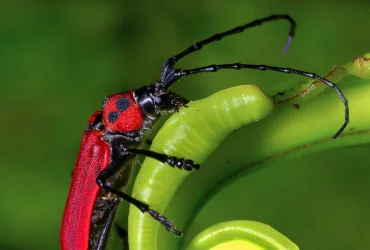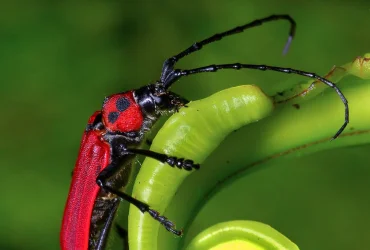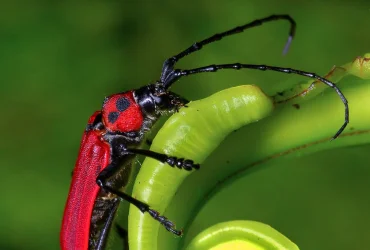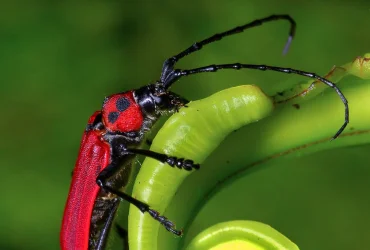Archives
 v5i1.94
v5i1.94ISSN: 1800-427X (print)
eISSN: 1800-427X (online)
DOI:10.47605/tapro.v5i1.94
Submitted date: 12 March 2013
Accepted date: 9 April 2013
Published date: 15 June 2013
Pp. 71–72.
Rediscovery of Sonerila andamanensis Stapf & King, 1900 (Melastomataceae)
S.P. Mathew* & P Laksminarashimhan
*Corresponding author. E-mail: sampmatthew@rediffmail.com
The type collection of Sonerila andamanensis Stapf & King in King (1900) mentioned in the protologue (King’s collector 48) from the Mt. Harriet Hills of South Andaman Island is presently not traceable at CAL and K. However, another specimen of this species collected from the Andaman Islands in 1884 also by King’s collector is deposited at Kew with the barcode accession no K000867666. This specimen was annotated as S. maculata Roxburgh in 1975 by Panighrahi from the Botanical Survey of India. A perusal of literature and herbarium survey has revealed that S. maculata has not been reported from Andaman–Nicobar Islands, and no literature or any other valid documentation are available showing S. andamanensis is a synonym of S. maculata.
Section Editor: James L. Reveal
eISSN: 1800-427X (online)
DOI:10.47605/tapro.v5i1.94
Submitted date: 12 March 2013
Accepted date: 9 April 2013
Published date: 15 June 2013
Pp. 71–72.
Rediscovery of Sonerila andamanensis Stapf & King, 1900 (Melastomataceae)
S.P. Mathew* & P Laksminarashimhan
*Corresponding author. E-mail: sampmatthew@rediffmail.com
The type collection of Sonerila andamanensis Stapf & King in King (1900) mentioned in the protologue (King’s collector 48) from the Mt. Harriet Hills of South Andaman Island is presently not traceable at CAL and K. However, another specimen of this species collected from the Andaman Islands in 1884 also by King’s collector is deposited at Kew with the barcode accession no K000867666. This specimen was annotated as S. maculata Roxburgh in 1975 by Panighrahi from the Botanical Survey of India. A perusal of literature and herbarium survey has revealed that S. maculata has not been reported from Andaman–Nicobar Islands, and no literature or any other valid documentation are available showing S. andamanensis is a synonym of S. maculata.
Section Editor: James L. Reveal
 v5i1.93
v5i1.93ISSN: 1800-427X (print)
eISSN: 1800-427X (online)
DOI:10.47605/tapro.v5i1.93
Submitted date: 19 January 2013
Accepted date: 8 February 2013
Published date: 15 June 2013
Pp. 69–70, Pls. 9–10.
Rediscovery of Ophiorrhiza radicans (Rubiaceae) from the southern Western Ghats, India
E.S.S. Kumar*, S.S. Kumari & P.E. Roy
*Corresponding author. E-mail: santhoshkumares@gmail.com
As part of the collection and ex–situ conservation of the rare, endangered and threatened plants of the Southern Western Ghats, Ophiorrhiza radicans Gardner ex Thwaites (1859) was rediscovered from the Rosemala Estate of the Kollam District in Kerala after 119 years of its last record. The identity was confirmed by cross–matching the new collection with the type specimen (Sri Lanka, C.P. Thwaites 1706, K!) housed at Royal Botanic Gardens, Kew.
Section Editor: James L. Reveal
eISSN: 1800-427X (online)
DOI:10.47605/tapro.v5i1.93
Submitted date: 19 January 2013
Accepted date: 8 February 2013
Published date: 15 June 2013
Pp. 69–70, Pls. 9–10.
Rediscovery of Ophiorrhiza radicans (Rubiaceae) from the southern Western Ghats, India
E.S.S. Kumar*, S.S. Kumari & P.E. Roy
*Corresponding author. E-mail: santhoshkumares@gmail.com
As part of the collection and ex–situ conservation of the rare, endangered and threatened plants of the Southern Western Ghats, Ophiorrhiza radicans Gardner ex Thwaites (1859) was rediscovered from the Rosemala Estate of the Kollam District in Kerala after 119 years of its last record. The identity was confirmed by cross–matching the new collection with the type specimen (Sri Lanka, C.P. Thwaites 1706, K!) housed at Royal Botanic Gardens, Kew.
Section Editor: James L. Reveal
 v5i1.92
v5i1.92ISSN: 1800-427X (print)
eISSN: 1800-427X (online)
DOI:10.47605/tapro.v5i1.92
Submitted date: 19 March 2013
Accepted date: 20 April 2013
Published date: 15 June 2013
Pp. 67–68, Pls. 7–8.
Cyperus surinamensis Rottbøll, 1772 (Cyperaceae): A new record for India
A.R. Viji, D. Tandyekkal & A.G. Pandurangan
*Corresponding author. E-mail: agpandurangan@gmail.com
Cyperus Linnaeus is the second largest genus in Cyperaceae Jussieu with some 600 species mostly distributed in the tropics and subtropics of the world. Of these, 70 species occur in India. They usually grow as part of wet land vegetation, mud banks, open areas, etc., and yet they get little attention from the floristic workers even though they contribute significantly to the economic and ecologic stability of the ecosystem/region.
Section Editor: James L. Reveal
eISSN: 1800-427X (online)
DOI:10.47605/tapro.v5i1.92
Submitted date: 19 March 2013
Accepted date: 20 April 2013
Published date: 15 June 2013
Pp. 67–68, Pls. 7–8.
Cyperus surinamensis Rottbøll, 1772 (Cyperaceae): A new record for India
A.R. Viji, D. Tandyekkal & A.G. Pandurangan
*Corresponding author. E-mail: agpandurangan@gmail.com
Cyperus Linnaeus is the second largest genus in Cyperaceae Jussieu with some 600 species mostly distributed in the tropics and subtropics of the world. Of these, 70 species occur in India. They usually grow as part of wet land vegetation, mud banks, open areas, etc., and yet they get little attention from the floristic workers even though they contribute significantly to the economic and ecologic stability of the ecosystem/region.
Section Editor: James L. Reveal
 v5i1.91
v5i1.91ISSN: 1800-427X (print)
eISSN: 1800-427X (online)
DOI:10.47605/tapro.v5i1.91
Submitted date: 18 October 2012
Accepted date: 9 April 2013
Published date: 15 June 2013
Pp. 60–66.
DISTRIBUTION AND ABUNDANCE OF THREE POPULATIONS OF INDIAN FLYING FOX (Pteropus giganteus) FROM PURULIA DISTRICT OF WEST BENGAL, INDIA
Somenath Dey, Utpal Singha Roy* & Sanjib Chattopadhyay
*Corresponding author. E-mail: srutpal@gmail.com
Abstract
The present study was carried out to monitor three roost sites of Indian flying fox (Pteropus giganteus) populations during the period November 2010 to October 2011 near Purulia, West Bengal, India. At all three sites, bats were found to occupy different tree species (Eucalyptus sp., Dalbergia latifolia, Tamarindus indica and Terminalia arjuna) outside villages for day roost sites in close proximity to water bodies. Behavioural observations were made based on all occurrence method where all behaviours observed for duration of 30 minutes was noted during each census for the entire study period. Favourable roosting conditions were found to support higher bat abundance. Moreover, bat abundance and ambient temperature were found to be negatively correlated, and mass die–offs and population decline were recorded in the hotter months of the year (April–July). Study of bat guano revealed aspects of their feeding habits and their pivotal role as seed dispersers. Information from local villagers affirmed that the bat populations occurring at the roost sites are more than a century old and are regarded as sacred. Moreover, no direct conflicts were recorded between the bats and villagers during the present study. According to the villagers bat populations are declining due to road expansion, cutting of trees and hunting by outsider nomads; these aspects need serious attention from the authorities concerned.
Key words : Chiroptera, habitat selection, vermin, behaviour, threats, ecology, conservation
Section Editor: Judith Eger
eISSN: 1800-427X (online)
DOI:10.47605/tapro.v5i1.91
Submitted date: 18 October 2012
Accepted date: 9 April 2013
Published date: 15 June 2013
Pp. 60–66.
DISTRIBUTION AND ABUNDANCE OF THREE POPULATIONS OF INDIAN FLYING FOX (Pteropus giganteus) FROM PURULIA DISTRICT OF WEST BENGAL, INDIA
Somenath Dey, Utpal Singha Roy* & Sanjib Chattopadhyay
*Corresponding author. E-mail: srutpal@gmail.com
Abstract
The present study was carried out to monitor three roost sites of Indian flying fox (Pteropus giganteus) populations during the period November 2010 to October 2011 near Purulia, West Bengal, India. At all three sites, bats were found to occupy different tree species (Eucalyptus sp., Dalbergia latifolia, Tamarindus indica and Terminalia arjuna) outside villages for day roost sites in close proximity to water bodies. Behavioural observations were made based on all occurrence method where all behaviours observed for duration of 30 minutes was noted during each census for the entire study period. Favourable roosting conditions were found to support higher bat abundance. Moreover, bat abundance and ambient temperature were found to be negatively correlated, and mass die–offs and population decline were recorded in the hotter months of the year (April–July). Study of bat guano revealed aspects of their feeding habits and their pivotal role as seed dispersers. Information from local villagers affirmed that the bat populations occurring at the roost sites are more than a century old and are regarded as sacred. Moreover, no direct conflicts were recorded between the bats and villagers during the present study. According to the villagers bat populations are declining due to road expansion, cutting of trees and hunting by outsider nomads; these aspects need serious attention from the authorities concerned.
Key words : Chiroptera, habitat selection, vermin, behaviour, threats, ecology, conservation
Section Editor: Judith Eger
 v5i1.90
v5i1.90ISSN: 1800-427X (print)
eISSN: 1800-427X (online)
DOI:10.47605/tapro.v5i1.90
Submitted date: 7 June 2012
Accepted date: 30 November 2012
Published date: 15 June 2013
Pp. 50–59.
BAT FAUNA OF THE WESTERN HIMALAYA OF INDIA: A ZOOGEOGRAPHIC PERSPECTIVE
Uttam Saikia* & Ananda Ram Boro
*Corresponding author. E-mail: uttamzsi@gmail.com
Abstract
A zoogeographic analysis of the chiropteran fauna of western Himalayan states of Himachal Pradesh (HP) and Jammu & Kashmir (J&K) is presented. Based on field surveys, study of museum specimens and published literature, 44 species of bats in 20 genera have been reported from the study area. By virtue of its transitional position between the Oriental and Palearctic biogeographic realms, the chiropteran fauna of western Himalaya exhibit an intermixing of elements from both the realms. At the species level, Oriental elements (25 species) dominate Palearctic (17 species) and Ethiopian (1 species) components, while the zoogeographic affinity of one species, Miniopterus schreibersii, is indeterminate. Some zoogeographic aspects influencing the present faunal composition of the region are also discussed. Considering the lack of studies on bat fauna in this part of the Himalaya, it is expected that intensive studies will shed new light into the zoogeography of these lesser known mammals.
Key words : Chiroptera, species diversity, zoogeographic affinity, disjunctive distribution
Section Editor: Judith Eger
eISSN: 1800-427X (online)
DOI:10.47605/tapro.v5i1.90
Submitted date: 7 June 2012
Accepted date: 30 November 2012
Published date: 15 June 2013
Pp. 50–59.
BAT FAUNA OF THE WESTERN HIMALAYA OF INDIA: A ZOOGEOGRAPHIC PERSPECTIVE
Uttam Saikia* & Ananda Ram Boro
*Corresponding author. E-mail: uttamzsi@gmail.com
Abstract
A zoogeographic analysis of the chiropteran fauna of western Himalayan states of Himachal Pradesh (HP) and Jammu & Kashmir (J&K) is presented. Based on field surveys, study of museum specimens and published literature, 44 species of bats in 20 genera have been reported from the study area. By virtue of its transitional position between the Oriental and Palearctic biogeographic realms, the chiropteran fauna of western Himalaya exhibit an intermixing of elements from both the realms. At the species level, Oriental elements (25 species) dominate Palearctic (17 species) and Ethiopian (1 species) components, while the zoogeographic affinity of one species, Miniopterus schreibersii, is indeterminate. Some zoogeographic aspects influencing the present faunal composition of the region are also discussed. Considering the lack of studies on bat fauna in this part of the Himalaya, it is expected that intensive studies will shed new light into the zoogeography of these lesser known mammals.
Key words : Chiroptera, species diversity, zoogeographic affinity, disjunctive distribution
Section Editor: Judith Eger
Hubungi Kami
The ultimate aim of the journal is to provide an effective medium for communication of the latest and best scientific information.
Copyright © 2020 Taprobanica. All Rights Reserved
Jasa Pembuatan Website by IKT




